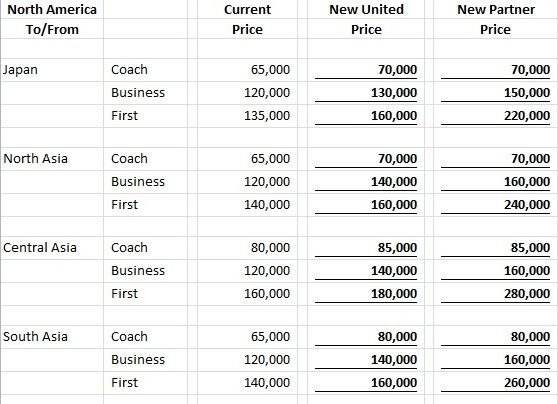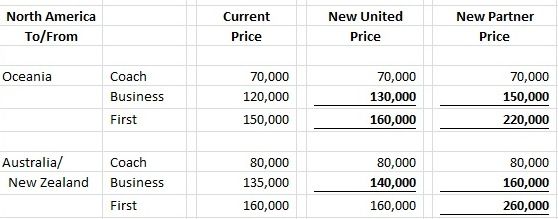United devaluation: I woke up this morning to an announcement of some really nasty changes to the United MileagePlus award chart. These changes don’t go into effect until February 1, so you will want to issue tickets you may be considering before then (and not make changes to tickets after that).
What United has done is
- Announced an increase in the price of many of its awards
- Bifurcated its award chart so that partner awards will often cost a whole lot more than awards on United’s own flights
There aren’t actually very many changes to awards in North and South America. There aren’t very many changes to awards in coach. The biggest bloodbath is to first class partner award pricing.
Here are .pdfs of the current chart and the new chart.
But to make it easier I’ve put together side-by-side comparisons of the award charts starting or ending travel in North America. I’ve bolded and underlined prices that are changing.
Again, North and South America have the fewest changes.

Europe and Africa is where things start to get bad.

Check out first class changes:
- First class between North America and Europe on partner airlines goes from 135,000 miles roundtrip to 220,000 miles roundtrip. That’s a 63% increase.
- First class between North America and the Middle East on partner airlines goes from 150,000 miles roundtrip to 280,000 miles roundtrip. That’s an 87% increase.
- First class between North America and Africa on partner airlines goes from 150,000 miles roundtrip to 260,000 miles roundtrip. That’s a 73% increase.
I’ve always loved first class awards to Asia, especially on United’s Asian partner airlines.

Check out first class changes:
- First class between North America and Japan on partner airlines goes from 135,000 miles roundtrip to 220,000 miles roundtrip. That’s a 63% increase.
- First class between North America and North Asia on partner airlines goes from 140,000 miles roundtrip to 240,000 miles roundtrip. That’s a 71% increase.
- First class between North America and Central Asia on partner airlines goes from 160,000 miles roundtrip to 280,000 miles roundtrip. That’s a 75% increase.
- First class between North American and South Asia on partner airlines goes from 140,000 miles roundtrip to 260,000 miles roundtrip. That’s an 86% increase.
And finally here are the changes to Oceania and Australia/New Zealand

Check out first class changes:
- First class between North America and Oceania on partner airlines goes from 150,000 miles roundtrip to 220,000 miles roundtrip. That’s a 47% increase.
- First class between North America and Australia/New Zealand on partner airlines goes from 160,000 miles roundtrip to 260,000 miles roundtrip. That’s a 62% increase.
Of course, changes aren’t limited to awards between North and South America. One award I’ve been keen on in the past — intra-Asia business class goes up from 35,000 miles roundtrip to 60,000 miles.
These Changes Compare Unfavorably to the Worst of What Other Airlines Have Done
This is one of the worst guttings of a frequent flyer award chart that I have seen, worse even than what Aeroplan did in 2011 and with negatives on par with what British Airways did two years ago but without the countervailing improvements like discounted short-haul awards (British Airways awards now start at just 4500 points each way).
In fairness, changes to awards on United aren’t nearly as bad as they are to changes to awards on partner airlines. But those partner airlines often have better availability, not to mention a much better inflight product.
And changes to business class awards aren’t nearly as bad (though they are bad!) as changes to first class awards. The crazy thing though is that first class awards can now be even more than triple the price of coach, where once they may have been just double.
If there’s one silver lining, it’s that at some level things could have been even worse (you can always make things worse!). At least they didn’t announce that they’re adding fuel surcharges to award tickets.
An Award Chart Devaluation Was Long Overdue
It’s actually been a long time since United has done anything like this.
- United restricted advance booking of awards on Lufthansa and ANA in the fall of 2004, on the heels of reducing award hold times from 30 days to 14 days to 3 days (now accounts with miles in them are not officially allowed to place awards on hold at no charge).
- They made big changes to their award chart in October 2006 (and introduced close-in booking fees).
- They made big changes again effective January 2009, including the introduction of cash co-pays for upgrades six months later.
There was what seemed like a pattern of devaluing every couple of years. So it was no surprise when they tweake the chart in 2011. At the time though they were more focused on merging with Continental, on aligning their policies with Continental (read: becoming Continental and adopting Continental’s award chart) that the changes were really quite modest.
And it’s easy to forget that the Continental merger brought with it an end to ‘blocking’ of partner award seats. United used to program their computers to pretend that their partners were not offering them award seats, when the partners actually were, because the MileagePlus didn’t want to pay for those seats. Telephone agents would tell customers the seats weren’t being offered to United, which was false.
When Continental joined Star Alliance they promised an award chart that was more ‘realistic’ so that they could afford not to engage in this deceptive practice, and they ended what they internally referred to as ‘throttling’ when they took over leadership of United,
But Continental executives were surprised by how much partner awards were costing them, and in some ways I’m surprised by how long it’s taken them to do something about it. Presumably they figure that the drama and reputational hit they took when actually combining the airlines in March 2012 (creating a very bad airline in the process) has mostly passed, they didn’t take too much of a hit this past summer with the introduction of minimum revenue requirements for elite status and increased change fees on award tickets. Very frequent flyer Un-friendly.
Here’s How Others May Follow United’s Devaluation
The worst thing about this, from a flyer’s perspective, is that with the consolidation in the airline industry there are fewer players and less of a barrier to changes like this across the board. Delta miles are already worth very little. Even with these changes I’d take United miles over Skypesos. And Delta has just increased the price of international business class awards (not that they wouldn’t go even further, and without advance notice, since they consider award charts ‘to be like pricing making it illegal to tell customers about changes in advance; presumably they believe United’s advance notice here is illegal even if the government and indeed the rest of the world disagrees).
It’s been nearly four years in US Airways devalued its chart. American’s chart used to be the most expensive and they haven’t devalued in quite awhile. If a merger between those two airlines goes through my bet has been a period of quiet, no need to push customers away, they’ll “take the best of both carriers’ programs.” But given a little bit of time there’s not much reason to expect them not to follow suit. (Randy Petersen has suggested the opposite, that a merged carrier could do a ‘big bang’ change upon combination; pulling off the band-aid in one go, and a change like United has announced I think makes that more plausible since whatever they do could be spun as not being worse than that).
Here’s What to Do Right Now, and In the Future
I’m issuing a sell recommendation on United miles.
Or, more specifically, burn those that you have already banked now, or at least ticket by the end of January. Earn more for future use with a rational understanding that they will be worth less, so the effort you go to in order to accumulate the miles should be less, and when considering which miles to earn it should take earning more United miles than a competitor currency like American points to get you to choose United.
Finally, remember that miles are not a good store of value. They are a propriety currency with no independent central bank, let alone currency board, no mandate to minimize award price inflation. You should always earn and burn in roughly the same period. Miles are worth more today than they will be tomorrow. Your best hedge, and it’s not true protection since these programs can change too, is to save up currencies that can be transferred effectively to a variety of different frequent flyer programs (Chase Ultimate Rewards, American Express Membership Rewards, Starwood Preferred Guest).
- You can join the 30,000+ people who see these deals and analysis every day — sign up to receive posts by email (just one e-mail per day) or subscribe to the RSS feed. It’s free. You can also follow me on Twitter for the latest deals. Don’t miss out!


Airlines are CHEATING customers outrageously because the yare raising the actual tickets prices AND raised revenue with crap like charging for checked bags. So, we are all already paying more to earn miles!!!! Airlines are double dippers when it comes to screwing passengers!!!!
I understand that bookings made (before 2/1) can have a change of travel dates (after 2/1) and nothing else without a penalty that triggers the new, higher rates (whether your booking a first/business class or Star Alliance carrier. That existing rule stay in affect. But what happens if I book a flight now and make a date change…does the routing HAVE to be on the same metal? If there is something else available on a different airline, do any changes kick in, or does the routing from origin/destination have to be on the same carrier? That rule might be in place right now, I just don’t know off hand. For example, if I booked a non-stop now (for travel in March) SFO to NRT on UAL, can the new rebooking dates be made on ANA (assuming seats are available) without paying more? And vice versa?
It’s really not that bad. I purchase coach seats and then use miles for upgrades. The upgrades have barely changed if not at all. I fly to D.C. to LAX and it’s usually 40k miles round trip. That hasn’t changed. Same with U.S. to Europe. It’s still 40k round trip. Your miles stretch further this way anyways.
Your chart showing the current and changed United awards is missing CRITICAL information. The 25,000 for a domestic award ticket is not 25,000. If you read their chart and information, you will see that they now calculate only 1 way for your 25,000 award. That means you need to spend 50,000 if you intend to fly back!
@Amy Schaffer – that’s not correct
its pretty hard to find a united roundtrip for 25,000 miles unless it is a really short haul and or far away in the future and or on select days of the month